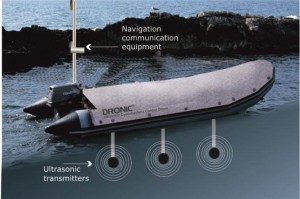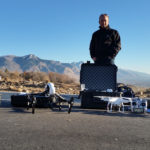By William Renz
There is a hidden cost intertwined with the production of our food. Growing crops along the coasts can be a traumatic experience for aquatic ecosystems. Large, harmful algae colonies are an externality of agriculture in these areas. The algae robs nutrients of the sea and can make the waters a harsh environment for life that once thrived in those regions.
One European consortium plans to battle this problem with an innovative use for drones: drones that can eliminate algae autonomously. This project, labeled the Dronic Project, will use advanced algae management technology and the pledges of several companies to cut algae levels to that which are less toxic to their environment.
Harmful species of algae in the water can introduce toxins into their environment and devastate it. They can introduce something called paralytic shellfish poisoning which kills many mussels and clams. This not only impacts the environment a great deal but also the fishing industry of shellfish. If the blooms are large enough, they may rob the sea life of necessary oxygen and create large dead zones. These blooms of algae are created when there is an excess of nitrogen in the ocean water.
Fertilizers used in agriculture are heavy in nitrogen and through irrigation they are pumped into large bodies of water via rivers and streams. A study by Stanford researched the impact of farming and fertilizer on the occurrence of red tide. Their study in the Yaqui River Valley in Mexico showed that within week of irrigation events of the valley, large blooms of harmful algae would appear and last several days. Algae that collects in reservoirs and lakes may also get in the public drinking water and have adverse health effects.
The proposed method of treatment of algae types includes a relatively new technique involving ultrasonic application to the blooms. One study in the journal “Desalination” showed that applying ultrasonic sounds to blooms for only 15 seconds improved results of removal by current techniques by over 10 percent. The coordinating company in the Dronic Project, LG Sound, lists that ultrasonic treatment of the water not only prevents growth of algae but it is also free of harsh chemicals, requires minor maintenance, and it won’t damage industrial systems such as water filters in treatment plants. The technology that is being implemented into the drones won the Shell LiveWIRE award this past December for being innovative. Despite the positives of the technology, there are limitations to it. The major limitation is the range of the technology. The Dronic Project aims to remedy this by attaching the ultrasonic producing devices onto drones.
The exact method for autonomous algae treatment involves a “master drone” and plentiful “slave drones.” The drones are different from those styles which are popular in the media today. They are autonomous rafts that travel on the surface of the water, powered by a boat engine.
The master drone travels around the surface of the water along a programmed route searching for the algae hotspots. It moves along the route, taking measurements of the quality of the water and mapping the algae concentrations along the way. If there is a large concentration of blooms in one area, the master drone will call to a slave drone to come treat the water by using navigation communication equipment that is on all of the drones. The slave drones are those which have the ultrasonic treatment abilities. The slave drones motor out to the precise spot the master drone indicated and treat the water.
If there is a large concentration of blooms in one area, the master drone will call to a slave drone to come treat the water by using navigation communication equipment that is on all of the drones. The slave drones are those which have the ultrasonic treatment abilities. The slave drones motor out to the precise spot the master drone indicated and treat the water.
According to the Dronic Project, benefits are not only environmental but economic as well. Current methods of treatment of lake water for algae include treatment of the entire body of water which is costly and can be environmentally hazardous to whatever calls the water home. Cleansing the entire lake when only a specific section is in need is economically frivolous as well. The Dronic Project aims to treat only the algae blooms at their sources to decrease their environmental and economic footprint.
The funding and equipment for the project comes from eight various technology companies from the Netherlands, France, Belgium, Slovenia, Cyprus, and the U.K. The group has gathered over two million euros to support the Dronic Project but they are still lacking over one million euros of what their estimated project costs.
Through the use of ultrasonic treatment of water and master and slave drones, The Dronic Project is hoping to increase the efficiency of algae removal while decreasing its environmental impact. The drones are innovative in their technological elements as well as their aquatic drone design that opposes the popular aerial design. The culmination of the innovations and hard work of the Dronic Project will help to eliminate harmful algae blooms that left untreated are very harmful to their environments, both in their disruption of the ecosystem and tainting of drinking water.


